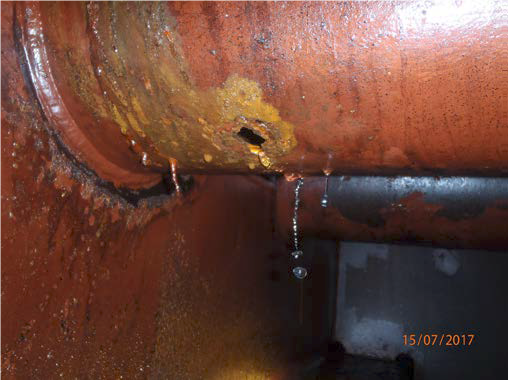Failure of pipework in fuel tanks
What happened?
Water ingress into a fuel tank was discovered to be from leaking pipework. Water ingress was reported into a fuel tank from two seawater lines running through the tank. Engineers investigating a high-level alarm on the fuel tank initially thought it was due to vessel movement. But upon inspection of the pipework, a leak was found on a sea water pipe approximately 150mm outboard from the Pump Room bulkhead.

What went wrong? What were the causes?
There was a hole of around 13mm diameter in the pipe, which had caused seawater leakage into the tank and thus, a rise in level. Fuel was transferred from this tank to the port side settling tank and shortly after starting the transfer, the port side fuel separator tripped out. The 3rd engineer went to clean the strainer and quickly realised that a large amount of water was present in the system. A check on the settling tank drain confirmed that there was water present.
The cause was failure of pipework installed on the vessel at build stage.
What lessons were learnt? What actions were taken?
- Clarification of fuel tanks on vessels if pipework lengths run through tanks;
- Inspection of pipework in tanks for integrity through visual and ultrasonic thickness baseline measurements.
On the IMCA website, entering corrosion into the safety flash page search bar generates 60 results which members may wish to check for themselves.

Members may wish to review the following incident:
Safety Event
Published: 21 September 2017
Download: IMCA SF 23/17
IMCA Safety Flashes
Submit a Report
IMCA Safety Flashes summarise key safety matters and incidents, allowing lessons to be more easily learnt for the benefit of all. The effectiveness of the IMCA Safety Flash system depends on Members sharing information and so avoiding repeat incidents. Please consider adding safetyreports@imca-int.com to your internal distribution list for safety alerts or manually submitting information on incidents you consider may be relevant. All information is anonymised or sanitised, as appropriate.
IMCA’s store terms and conditions (https://www.imca-int.com/legal-notices/terms/) apply to all downloads from IMCA’s website, including this document.
IMCA makes every effort to ensure the accuracy and reliability of the data contained in the documents it publishes, but IMCA shall not be liable for any guidance and/or recommendation and/or statement herein contained. The information contained in this document does not fulfil or replace any individual’s or Member's legal, regulatory or other duties or obligations in respect of their operations. Individuals and Members remain solely responsible for the safe, lawful and proper conduct of their operations.
